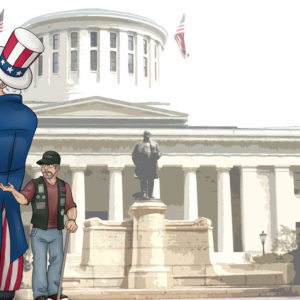The Value of Vintage Frogskin Camouflage
By Frank Arian, MD
As we approach the 75th anniversary of the bombing of Pearl Harbor, World War II artifacts and garments are more popular than ever. World War II debuted the first widespread use of interrupted color camouflage garments. That camouflage pattern is known today as frogskin camo and it is one of the most highly sought after of all WWII artifacts. It is credited as the first United States camouflage pattern. It was named so for perhaps two reasons: 1) it resembles some color schemes of frogs 2) the interrupted color splotches resemble frogs. Regardless of from where the name came, frogskin is BIG BUSINESS.
In the 1940s, frogskin camo garments were allocated to the Marines fighting the Pacific Campaign and to a limited number of Army units in the European Theatre of Operations, most notably the 2nd Armored Division. The Germans had a highly evolved set of different camouflage garments which resulted in some confusion and friendly fire incidents in the ETO. The frogskin camo garments were withdrawn from use in the ETO because of these incidents. Consequently, the production of frogskin camo uniforms and field gear was limited. Because of this, the supply is low, the demand is high, and the prices are high.
There were not a great many types of frogskin garments and field gear produced. Appreciating this rare camouflage first involves learning about what was made. Below is a list of the frogskin garments and field gear that were made and common prices today for mint specimens.
COMBAT UNIFORM
The first style of frogskin combat camo uniform was issued as a one-piece jungle jumpsuit. It had built in suspenders to help keep the suit up under load. It is rare to find these specimens with the suspenders intact as many were cut off in the field as they were felt to be a nuisance and very warm. The one-piece jungle jumper fell rapidly out of favor by Marines as it was way too hot to wear in the Pacific and made evacuating bodily functions a major operation, leaving the Marine quite vulnerable.
Note that step number one in authenticating frogskin camo is the presence of Herringbone Twill in the Army pattern, not in the USMC pattern. The USMC pattern of Herringbone Twill is HBT in a true chevron pattern. The material repeats rows of chevrons. This type of HBT was used on the green USMC utilities from WWII. The Army pattern of which all frogskin camo uniforms were made has a non-slanting row interfering alternately with the chevrons. Again, this is the absolute first step in identifying an authentic garment. True chevron material instantly identifies a remake.
Approximate Value or a One-Piece Jungle Coverall Suit ($600-$1000)
P42 COMBAT SHIRTS AN PANTS
R & D went back to the drawing board following the failure of the one piece suit and then issued the P42 combat shirt and pants. The design was simple. The shirt and pants featured frogskin Herringbone Twill. The shirt had a front bottom right top opening pocket with brown button closure. The right chest featured a patch pocket with USMC Eagle Globe Anchor stamp and no button closure. It had midline snap closures and was reversible frogskin with a green pattern opposite a beach brown pattern. The pants were also reversible and had domed snap pockets or metal buttons. The pocket configuration was front right slash and rear left patch. Once broken in, the camo uniform wore like a comfortable pair of pajamas.
Because P42s were used in all the legendary campaigns such as Tarawa, Bougainville, Peleliu and New Guinea among others, they are the most sought after of the basic frogskin uniforms. People like to own and wear what heroes wear. The P42s are associated with all the early victorious battles that were publicized in the newsreels. They are very hard to find in mint condition as most made it to battle due to the limited production runs.
Approximate Values for Combat Shirts and Pants & Other Items
- P42 USMC Combat Shirt ($700-$1800 with large sizes at high end)
- P42 USMC Combat Pants ($500-$1400 with large sizes at high end)
- Army Combat Shirt ($800-$1500)
- Army Combat Pants ($400-$800)
- USMC Paramarine Camo Smock 1st Pattern (2000-3500)
- USMC Paramarine Camo Smock 2nd Pattern ($2000-$3500)
- USMC Parachute Troop Utility Coat ($1600-$2000)
- USMC Parachute Troop Utility Pants ($1200-$1600)
P44 COMBAT SHIRTS AND PANTS
Late in the war, P44 combat shirts and pants were issued. They were quite different than the P42s. P44 shirts had large buttoned vertical slash pockets just to the side of the midline button closures. The trousers had large three- or four-button side snap flaps. One pocket connected to the other pocket in the seat of the trouser, creating a pouch in which garments like a poncho could be carried. Drawstrings on the ankle cuffs were found in the 1st pattern P44s. Because these P44s arrived late in the war, it is much more common to find mint unissued specimens than the P42s.
Approximate Values for P44 Combat Shirts and Pants
- P44 USMC Combat Pants Type I ($400-$800 with large sizes at high end)
- P44 USMC Combat Pants Type II ($400-$800 with large sizes at high end)
- P44 USMC Combat Shirt ($500-$900 with large sizes at high end)
- P44 USMC Combat Shirt ($500-$900 with large sizes at high end)
CAMO HELMET COVERS
One of the iconic garments from the WWII Pacific Campaign is the camo helmet cover. These helmet covers, now very scarce and pricey, were produced in three patterns. The first pattern had no foliage slits and was a two-piece construction. The second pattern had 16 slits that were sewn reinforced for foliage insertion. The third pattern had the 16 slits plus one buttonhole on each flap. Later in the war, the versatile helmet cover mosquito netted sniper veil was produced and can be found often these days and is reasonably priced. No collection or display is complete without a USMC reversible helmet cover and helmet.
Approximate Values for Helmet Covers and Sniper Veils
- Helmet Cover Type I ($500 mint with cutter ftag)
- Helmet Cover Type II ($500 mint with cutter tag)
- Helmet Cover Type III ($500 mint with cutter tag)
- Helmet Cover Mosquito Netted Sniper Veil ($25-$50)
HOODLESS PONCHOS
The frogskin hoodless poncho can be found today and is a bit different in its color scheme, but frogskin nonetheless. It comes stamped with service and date and the USMC stamped ponchos are the most sought after. When purchasing, be sure to check that they are soft and supple, as they become hard and brittle if not stored properly.
Approximate Values for Ponchos
- Poncho ($65-$150)
JUNGLE PACKS
The Army issued frogskin jungle packs, which were a military interpretation of the classic climbing Klettersac. The amount of gear a soldier could carry was increased and eventually a few spilled over to the Marines. They have an early version with a brown predominant pattern, lacking lower front slide fasteners and the later green predominant pattern with the lower front slide fasteners. The date and makers are stamped inside the zippered lid and these packs are scarce but available to date. Later in the war the jungle pack was enlarged in dimensions to accommodate winter weather gear, and sent to the ETO in olive drab.
Approximate Values for Jungle Packs
- Jungle Pack (Early) ($300-$500)
- Jungle Pack (Late) ($300-$500)
SHELTER HALFS
The frogskin shelter half was very similar to the olive drab and khaki versions. Two halves buttoned together along the ridgeline to form a complete tent. These were rolled into tubes with five tent stakes and three poles, carried atop the USMC Haversack. These are commonly seen in movies and newsreels. It is a stunning piece of field gear in mint condition; fully assembled. It makes a great display. These are scarce but available.
Approximate Values for Shelter Halfs/Straps
- Shelter Half ($250-$350)
- Shelter Half Straps ($10-$20 each)
BAZOOKA BAGS
The bazooka bag is one of the most sought after pieces of frogskin field gear. It is estimated a maximum of 250 were made, many by riggers for Marines. Recently, one was discovered with the maker’s stamp and date, indicating that these, at least for a time, were regular issue. These fantastic bags remain rare and are very valuable.
Approximate Values for Bazooka Bags
- Bazooka Bag ($800-$1500)
GARMENT BAGS
Finally, frogskin garment bags were made for Marines on leave and in rear areas and can be found in mint condition for very reasonable prices. They were made all the way through the Korean War. They utilize the frogskin material found on the sniper veil helmet cover.
Frogskin camo represents some of the most celebrated battles in US history. Consequently, artifacts are heavily sought after and command high prices. These items make great displays in stores and help educate customers on US history and the evolution of camouflage. Some stores that desire to carry military antiques and more high line artifacts would do well to invest in frogskin articles. These artifacts go up in value every year and will never decline for any significant length of time.
Approximate Values for Garment Bags
- Garment Bags ($45-$90)
Approximate Values of Custom Items
- USMC Field Cap (market price)
- Demolition Bag (market price)
- Mosquito Bar ($100-150)
As far as reproduction frogskin uniforms go, they are available, but the market is woefully underserved. These specialty reproduction companies will not wholesale garments to retailers and sell only directly to the end customer. Considering we are moving into a cycle in which WWII will become very prominent and in the news with the 75th anniversary, import companies would do well to add frogskin uniforms to their lines. The market is substantial and wide open.
Everyone likes to buy, collect and wear what heroes wear. Frogskin camouflage is what heroes wore in the Pacific Campaign of WWII and a genuine frogskin artifact is a jewel indeed.



